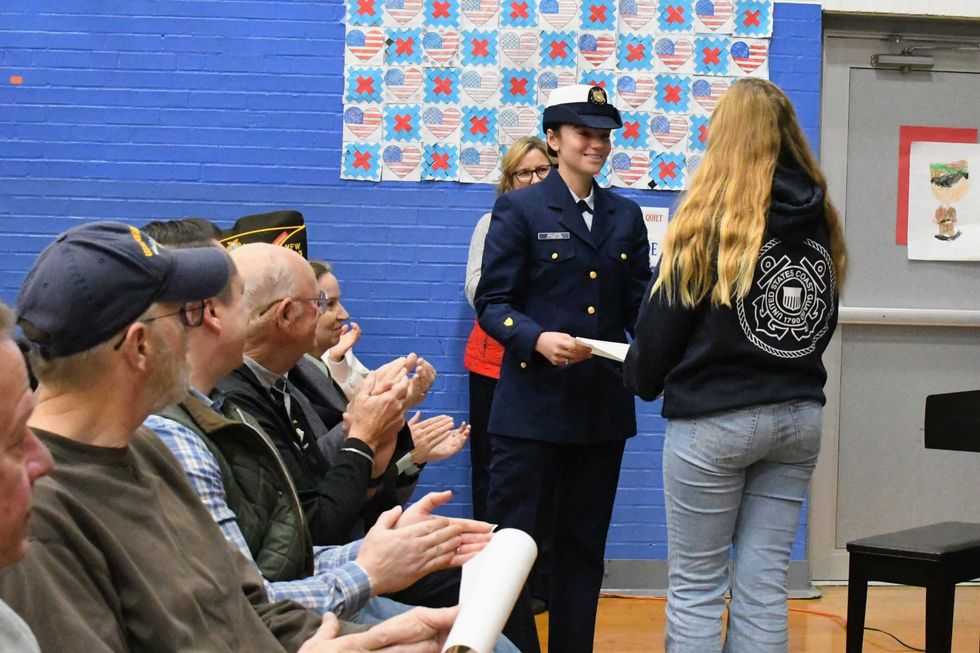Why we’re shipping our trash elsewhere

Area residents brought their trash and recyclables to the Salisbury-Sharon transfer station on Sunday, Feb. 20.
Photo by Patrick L. Sullivan

SALISBURY — It’s hard to imagine that it would ever get to this point. Up until recently, what we did with our waste in most of the Northwest Corner was quite simple: we bought a sticker at town hall, separated the trash from the recyclables, and took it all to the transfer station, where they would be taken care of.
Anything that might be reusable went into the Swap Shop, a dusty room full of what most people considered junk, but that others saw as an opportunity for reuse. The recyclables were turned over to a company that hauled them away to a facility that separated them, cleaned them and broke them down. If the towns were lucky, the recycling hauler would pay something for the privilege. The trash was sent to an incinerator in Hartford for a fee. End of story.
Before our towns started sending their garbage — known formally in Connecticut as municipal solid waste (MSW) — to incinerators, they deposited them in their own landfills. But by the 1990s, Connecticut had closed almost all of its dumps.
Most of the towns simply converted their landfills to transfer stations. Since 1975, Salisbury and Sharon operated a shared transfer station on land leased from The Hotchkiss School. That changed when the two towns leveraged their partnership to build a new $4.8-million transfer station on Route 44 near the New York state line.
The only landfill of any size remaining in the state is in Putnam, where a massive dump receives nearly 600,000 tons of ash per year from trash-to-energy plants such as the one that burns our waste in Hartford.
Now the situation has become much more complicated and likely much more expensive for our towns. Using two General Electric turbines that date back to the 1950s, the aforementioned trash-to-energy incinerator burns garbage and turns it into electricity — 45 megawatts, to be exact — enough to power 35,000 homes.
Located in the North Meadows section of Hartford and operated by the quasi-public Materials Innovation and Recycling Authority (MIRA), the facility we send our garbage to is on its last legs.
MIRA’s aging trash-to-energy plant, which handles an estimated 35% of the state’s waste, broke down in 2018 and was out of commission for several months, causing MIRA and its member towns, including Salisbury and Sharon, to scramble. Meanwhile, thousands of tons of garbage began to pile up inside and outside the aging facility.
“It was nerve-wracking,” MIRA President and CEO Thomas D. Kirk told the CT Mirror’s Tom Condon. “Thank God we didn’t have a fire.”
After a temporary fix in 2019, MIRA came up with a plan to replace the plant to the tune of $330 million. The administration of Gov. Ned Lamont practically laughed the proposal right out of the Capital City.
So MIRA’s board made the decision to shut down the trash-to-energy plant and use the property as a glorified transfer station from which to ship the garbage out of state for its remaining member towns.
MIRA’s problems, however, did not start with its busted incinerator. MIRA, formerly known as the Connecticut Resources Recovery Authority (CRRA), prompted ridicule, contempt and cries of injustice when, during the administration of then-Gov. John Rowland, it made an ill-fated $220 million loan to Enron, the energy-trading giant that later went belly-up in an accounting scandal.
When Enron defaulted, CRRA raised its tipping fees to cover its losses, resulting in a protracted and costly lawsuit from its then-70 member towns seeking compensation for the overcharging. The authority finally settled the suit for $21 million.
As one might expect, the antipathy between CRRA and its member towns extends well beyond an ill-advised and unsecured loan to a corrupt corporation. To wit, the authority took legal action in 2006 to try to stop the Salisbury-Sharon transfer station from sending its recyclables to a third party that paid the two towns for the raw materials.
Since it was accepting garbage from the two towns, CRRA insisted it was entitled to taking their paper recyclables as well. What was the price CRRA was willing to pay? Nothing. Town officials said the arrogance was staggering.
“They said they would take our junk mail and not charge us for it,” then-First Selectman Val Bernardoni quipped to this reporter. “They have 70 towns under contract; they’ll make a bundle.”
So it’s safe to say that there’s no reservoir of goodwill among MIRA’s member towns, including those in the Northwest Corner, which relies heavily on the authority. That’s probably why the Lamont administration wanted no part of approving MIRA’s pricey proposal to build a new incinerator. And reputation management might very well be the main reason the General Assembly allowed CRRA to change its name. If you Google MIRA, you won’t find much about its past problems as CRRA.
And so we find ourselves in quite a pickle. The costs of operating our transfer stations will rise — perhaps sharply. Thanks to COVID-related money from the federal government, states and municipalities can probably foot the bills in the short term.
But the day of financial reckoning will arrive soon enough. Last spring, MIRA put out requests for bids for contractors to haul away the waste from its facility. MIRA President and CEO Thomas Kirk told Condon its current disposal rate for garbage is $105.
If the 49 member towns don’t jump ship, Kirk forecasts a tipping fee of $114-$119 a ton in the first year of a five-year disposal contract, going to $139 in the fifth year. That rate could rise by $15 if more towns bail out on MIRA, or it could rise by even more if, as expected, MIRA must ship waste to landfills as far away as Alabama or Michigan. To give you a sense of perspective, as recently as 2019, the cost was $83 per ton.
With antiquated systems for collecting fees and perverse incentives for recycling still in place in our towns, the current trajectory is clearly unsustainable. What can we do? Stay tuned.
This is the first of a two-part series on Connecticut’s waste crisis and how it affects the Northwest Corner.
Chris Ohmen (left) held the flag while Chris Williams welcomed Salisbury residents to a Veterans Day ceremony at Town Hall Tuesday, Nov. 11.
SALISBURY — About 30 people turned out for the traditional Veterans Day ceremony at Salisbury Town Hall on a cold and snowy Tuesday morning, Nov. 11.
Chris Ohmen handled the colors and Chris Williams ran the ceremony.
Rev. John Nelson from Salisbury Congregational Church gave both an invocation and a benediction. The latter included this:
“We pray that those who have served and those who have died will never have done so in vain/We pray that the commitment of veterans will be an abiding call to resolve our conflicts without resorting to arms/ That one day soon we may mark the war that indeed ends all wars.”

Williams began his remarks by noting that the Veterans Day speech was usually given by the late David Bayersdorfer, who died earlier this year.
“As we honor our veterans today, let’s keep in mind that service comes in many forms. Each role, each job, each post is a vital part of what makes our military the finest in the world.”
Lloyd Wallingford sang “God Bless America” a cappella, with the crowd joining in.
Eden Rost, left, shakes hands with Sergeant Nicholas Gandolfo, veteran of the Korean War.
NORTH CANAAN — Students at North Canaan Elementary School saluted servicemen and servicewomen at a Veterans Day ceremony Wednesday, Nov. 12.
Eighteen veterans were honored, many of whom attended the ceremony and were connected to the school as relatives of students or staff.
The 2nd graders sang the official song for each branch of service represented that day: Army, Navy, Coast Guard, Marines and Air Force. Special recognition was given to the Marine Corps, which was founded 250 years ago in November 1775.
Eighth graders offered speeches of appreciation. Taylor Gulotta said, "My older sister, Madison, has worked so hard to get to where she is today. She has dreamt of being in the Coast Guard since she was a little girl." She continued, "Her selflessness and bravery... is truly inspiring."

Brayden Foley spoke of his grandfather Todd Baldwin's time in the Navy. "My grandpa taught me that helping others in a fundamental way can build strong, meaningful relationship and a supportive community. I appreciate all members of the Armed Forces past and present for their bravery and their commitment to protect the freedom that we have today."
Veterans were recognized individually by Principal Beth Johnson and students presented them with certificates.
The 2nd graders closed the ceremony with a choreographed rendition of "Grand Old Flag."

When longtime arts administrator Amy Wynn became the first executive director of the American Mural Project (AMP) in 2018, the nonprofit was part visionary art endeavor, part construction site and part experiment in collaboration.
Today, AMP stands as a fully realized arts destination, home to the world’s largest indoor collaborative artwork and a thriving hub for community engagement. Wynn’s departure, marked by her final day Oct. 31, closes a significant chapter in the organization’s evolution. Staff and supporters gathered the afternoon before to celebrate her tenure with stories, laughter and warm tributes.
“We had such a fun party for her,” said AMP founder and artistic director Ellen Griesedieck. “I am excited for what is next for Amy and grateful for every moment she has invested in her work at AMP.”
Wynn, who previously led the Northwest Connecticut Arts Council, said her decision to step down came after careful reflection.
“It’s time for me to shift into the next phase of my career, which will call upon my 40-plus years of nonprofit experience to do project work,” she said. “I’ve absolutely loved my time at AMP.”

Under Wynn’s leadership, AMP expanded education programs, deepened community partnerships and oversaw key milestones in the creation of its monumental centerpiece — a three-dimensional mural stretching 120 feet long and five stories high — celebrating American ingenuity, industry and collaboration.
“Through all these years, Amy has worked with tireless enthusiasm for AMP, running day-to-day operations and guiding the overall direction of our mission,” Griesedieck said.
During Wynn’s tenure, AMP evolved from a concept into a dynamic cultural campus. She helped professionalize its structure, solidify its funding base and develop programs that drew visitors from across the state and beyond.
“The work she has accomplished, the hours of overtime she has logged, the mountains we have climbed together since that moment are many and miraculous,” Griesedieck said.
AMP also weathered challenging times, including the pandemic, which forced arts organizations to rethink audience engagement. Wynn guided the team during that uncertain period with a steady hand.
To ensure a smooth transition, AMP has brought on Renee Chatelain of RMCreative Solutions, LLC, an experienced consultant, attorney and arts administrator who previously worked with AMP on its capital expansion planning.
Chatelain will serve as interim executive director while a national search is conducted for AMP’s next leader.
“A longtime friend, Renee comes to us with a depth of knowledge on executive transition,” said Griesedieck. “As an attorney, a leader of several arts organizations and a classically trained dancer, she is particularly well-suited for this interim role.”
Though stepping down, Wynn said she will continue her work in the nonprofit field in a more flexible, project-based capacity.
“I’ll be seeking consulting projects with other nonprofits, assisting with grant work and strategic planning,” she said. “What I enjoy most is leading a collaborative effort and finding solutions to challenging problems.”

Even as AMP bids farewell to Wynn, its focus remains on the future. The next phase of development will focus on converting a second mill building into expanded programming and community space.
“The next step has got to happen,” Griesedieck said. “It’s absolutely what the Northwest Corner needs — a place for the community to congregate.”
The proposed expansion would create flexible areas for performances, workshops and public events, further establishing AMP as a cornerstone of the regional arts scene.
With community support and grants, AMP hopes to carry forward Wynn’s momentum into a new era.
“She is not leaving,” Griesedieck said. “Amy will always be here for us.”
Founded in 2001, the American Mural Project was conceived as a tribute to the American worker — a celebration of skill, creativity and perseverance. The mural, the largest indoor collaborative artwork in the world, was created with contributions from thousands of children, artists, teachers, tradespeople and volunteers nationwide.
Today, AMP offers tours, workshops, lectures and performances, all rooted in its mission: to inspire, invite collaboration and reveal the contributions people of all ages can make to American culture.
As Wynn turns the page, her legacy — from her calm, strategic leadership to the collaborative spirit she fostered — remains woven into the fabric of AMP’s story.